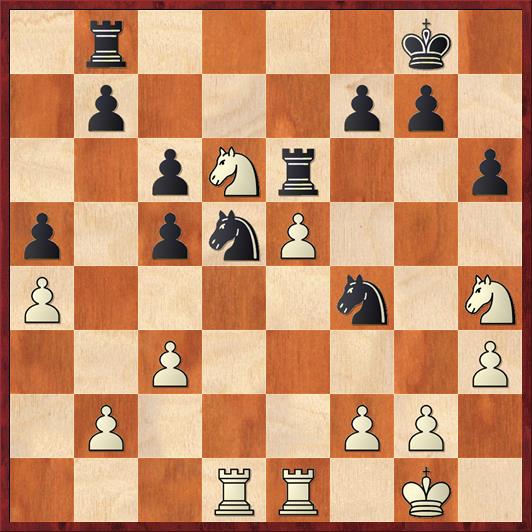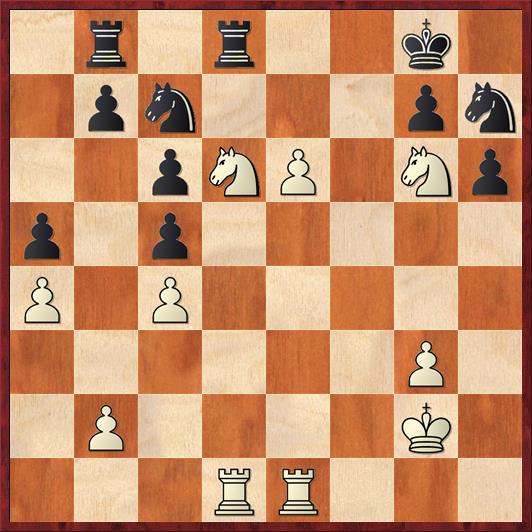Every landslide begins with one little pebble. And then another, and then a few rocks, and then a boulder, and then a whole hillside is moving …
That’s what it must have felt like for Alexander Grischuk when he was on the receiving end of an overwhelming, out-of-the-blue attack by Maxime Vachier-Lagrave in the fourth round of the World Cup. Here is the position just before the landside started.
 Position after 30. … Rb8. White to move.
Position after 30. … Rb8. White to move.
FEN: 1r4k1/1p3pp1/2pNr2p/p1pnP3/P4n1N/2P4P/1P3PP1/3RR1K1 w – – 0 31
This position came from a Giuoco Piano, one of the popular openings at this year’s World Cup. I have seen more Giuoco Pianos and English Openings at this tournament than ever before in my life. Clearly grandmasters playing the White pieces are taking a hard look at these “quiet” openings because they have gotten disenchanted with more ambitious openings that fizzle out into a draw.
The computer wants White to play 31. Kh2 here, preparing g2-g3. But Vachier-Lagrave says, “Why bother?”
31. g3! Nxh3+?
In retrospect, this loses by force. Black had to play 31. … Ng6, although his position remains difficult.
Grischuk doesn’t realize it, but he has just kicked the pebble that starts the landslide.
32. Kg2 …
From here until the rest of the game, twelve moves, every single White move attacks something. The next few moves (until move 39) are all easy to find; Vachier-Lagrave just has to ride the momentum downhill.
32. … Ng5 33. f4 Nh7 34. f5! Re7 35. c4! Nc7?!
One of the few places where Black has an option. With this move he tries to stop e5-e6 but he doesn’t succeed. Slightly better would have been 35. … Nb4, but then 36. e6! is still very strong.
36. e6! fe 37. Ng6 …
Every move leads to the next. Black’s pieces are fleeing the landslide, in complete disarray.
37. … Rd7 38. fe Rdd8
 Position after 38. … Rdd8. White to move.
Position after 38. … Rdd8. White to move.
FEN: 1r1r2k1/1pn3pn/2pNP1Np/p1p5/P1P5/6P1/1P4K1/3RR3 w – – 0 39
So far White has barely had to think. Nevertheless, I think we have all had games somewhat like this, in which we play one threat after another, but eventually the threats peter out, leaving us with an over-extended position. In fact, Grischuk may have been counting on that. But Vachier-Lagrave now puts a beautiful exclamation point at the end of the combination.
39. Ne7+! …
Maybe 39. e7 wins too, but it’s not so obvious. After 39. … Rd7 White cannot push to e8 because of the pin on the d-file, and Black gets a tempo to start regrouping with … Ne8, … Nf6, etc.
The first point of 39. Ne7+ is that Black can’t run to the corner, because 39. … Kh8? 40. Nf7 is checkmate! You don’t see that every day — a checkmate with two knights.
So Black’s next move is forced.
39. … Kf8 40. Nxc6! …
With three threats at once: Nxb8, Nxd8, and e7+. The last one is why it was important that Black had to move his king to f8.
Chess is so easy and fun when you can move your opponent’s pieces as well as your own!
40. … Rxd6 41. Nxb8 Ke7 42. Rxd6 Kxd6 43. Rd1+ Kxe6 44. Rd7 Black resigns.
From move 31 to 44, every White move either captured a piece or made a threat — sometimes both!
At the end of round four, the eight players who are still alive are Vassily Ivanchuk, Levon Aronian, Peter Svidler, Maxime Vachier-Lagrave, Wesley So, Vladimir Fedoseev, Richard Rapport, and Liren Ding. At this stage of most tournaments we would be talking about the “leaders” and there would be only two or three of them. But because the World Cup is a knockout tournament, all eight of these men go into the next round with an equal opportunity to win. Just another one of the things that makes the World Cup so much fun to watch!


